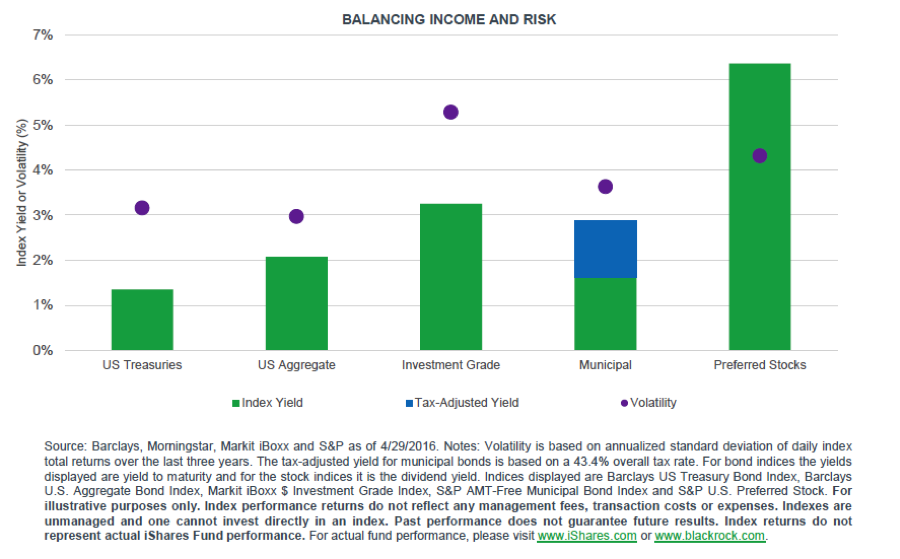Even as markets play an extended guessing game about the Fed’s next moves, the fact remains that the era of low – and even negative – global yields will likely be with us for some time to come.
Complicating matters are sluggish economic growth and stretched bond valuations, which have put investors in an all too familiar dilemma: Accept less income or take on more risk. Neither option is particularly attractive if you’re looking for meaningful, sustainable yield.
To reach an acceptable balance, however, the quest is no longer “Where do I go for yield?” but “What risks am I willing to take to generate the income I’m seeking?
We see three areas of potential opportunities that can open a door on attractive risk-adjusted yield. And at a time when returns are scarcer than usual, low-cost exchange traded funds (ETFs) may be an efficient way to access them.
Municipal bonds
Bonds, of course, have been the typical “go-to” for income investors, historically offering yield along with diversification benefits, capital preservation and growth potential.
These times are anything but typical, however. While the Federal Reserve has been easing off the gas pedal, they are doing so with an abundance of caution, keeping rate hikes incremental and well below normal. Today, with 10-year Treasuries touching record lows, there’s little room for either return or error; the risks have increased for a decline in bond values should rates rise. Low returns have in turn sent many investors to riskier bonds, notably high yield debt, which have seen spreads tighten.
Municipal bonds may offer a sweet spot between income and risk – and not just for those in the highest tax brackets. Among the best-performing bond categories in 2015, munis can still provide one of the highest sources of yield potential, both on a risk- and tax-adjusted basis, as the chart below makes clear. Some things to be aware of: the muni market may be less liquid than for taxable bonds, with less publicly available information; and the bonds may be subject to certain taxes.

Because muni payments are backed by state or local governments or by project revenue, they have tended to be a relatively stable source of income. Indeed, muni defaults overall are exceedingly low: 0.24% vs. 11.16% for corporate bonds (Source: S&P as of 12/31/2015). Large defaults on the scale of Puerto Rico are rare, but they’re a potent reminder of the importance of minding risk.
Preferred stocks
These are an often overlooked option for investors looking to balance risk and yield. Preferred stocks live somewhere between stocks and bonds—income-generating securities that pay a fixed coupon but can also appreciate in value. While preferred stocks don’t have the same upside potential as their common brethren, they have tended to be less volatile while generating yields upward of 6%. (See previous chart.)
And what of preferreds in a rising rate environment? While prices could certainly be affected, we wouldn’t expect a sharp spike down, as any upward moves in rates are likely to be gradual. At the same time, most preferred issuers are banks and other financial companies, a sector that has seen strong improvements in their balance sheets. A good reminder, though, not to over-concentrate your holdings.
Dividend growth
Finally, income investors willing to take on equity risk can look to dividend-paying stocks, specifically focusing on companies with a history of dividend growth. These assets have delivered yields on a par with the Barclays U.S. Aggregate Index, yet with significantly more growth potential. And while yields of dividend growers may lag behind those of high dividend strategies, and dividend payments aren’t guaranteed, we believe these securities offer a more attractive risk profile in the form of cheaper valuations, more stable earnings and stronger balance sheets.
Finding balance with ETFs
Each of these assets carries risks, of course, but depending on the needs of clients, the risks may be reasonable relative to the yield opportunity. ETFs may offer a low-cost, targeted way to find balance through exposure to one or a combination of these markets. Three from iShares include: iShares National Muni Bond ETF (MUB), iShares U.S. Preferred Stock ETF (PFF) and iShares Core Dividend Growth ETF (DGRO).
Heidi Richardson is Head of Investment Strategy for U.S. iShares, part of the Global Investment Strategies & Insight (ISI) Group, which delivers macro and market insight, leveraging BlackRock's thought leadership platforms to provide iShares clients with executable investment ideas using iShares ETFs.
Click here to view a prospectus, which includes investment objectives, risks, fees, expenses and other information that you should read and consider carefully before investing. Investing involves risk, including possible loss of principal.
Diversification and asset allocation may not protect against market risk or loss of principal. The iShares Funds are distributed by BlackRock Investments, LLC (together with its affiliates, “BlackRock”).
This material represents an assessment of the market environment as of the date indicated; is subject to change; and is not intended to be a forecast of future events or a guarantee of future results. This information should not be relied upon by the reader as research or investment advice regarding the funds or any issuer or security in particular. iS-18645




